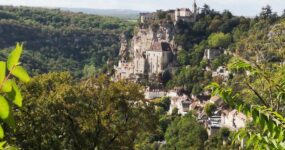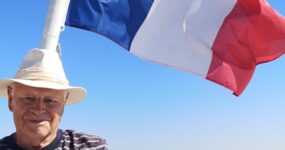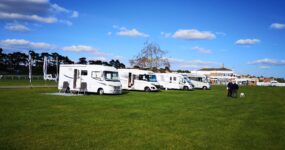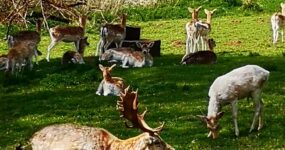A Wild and Windy Tour of Scotland, The Outer Hebrides and Northumberland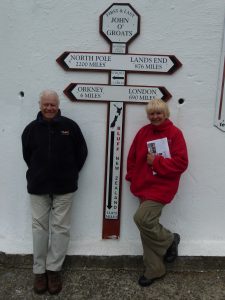
By Jenny Vowden
Our Motorhome travels this year took us to the most northerly points of Great Britain. Time was limited due to major alterations to our bungalow starting in June so a carefully planned route was organised to take in all the things we wanted to see and we set off for the first leg of our journey directly after the AGM at Stratford. Here follows a diary account of our travels.
Mon 2nd May Left Stratford. Easy drive to Penrith. Exit Junct. 41 to Cl. Town End Cottage Laithes. Excellent small level site. Very quiet. Scenic . Free range hens on site. £7.50 incl elect.
Tues 2nd Lovely morning. Coffee stop Johnstone Bridge. Dedicated caravan stopover £10 for 24hrs. Lunch stop at Loch Lomond picnic area. No Overnight camp signs everywhere and this was to continue throughout our tour of mainland Scotland. Stopped at Tarbert, easy to park, right by Loch Lomond, Boat Trips. Carried on A6 but stopped at the top of Rest and Be Thankful to have a look at the old Hillclimb Venue with beautiful views back down the Glen. Arrived at Inverary but No Caravan signs everywhere so did not stop! Carried on to Lochgilphead. Good campsite in small town. Lovely evening so got the bikes out and cycled part of the Crinan Canal which was very interesting. £14.50 incl elect.
Wed 3rd Beautiful morning. Drove down along the Crinan Canal to Crinan Harbour/Crinan Basin. Very pretty but narrow roads and difficult to park the van but well worth a visit.
Not that long ago, the more remote settlements along the west coast of Scotland were all supplied from the sea by small steamers affectionately known as ‘puffers’. These were grimy little steamships which stocked up in Glasgow then delivered their cargoes to the outlying settlements on the west coast. It was a long and perilous trip around Kintyre from Glasgow so a canal was built across the narrow neck of land separating Lochgilphead from the open sea and the Sound of Jura. The canal meets the sea at Crinan where a small dock was built to hold the puffers until the state of tide was right for the sea loch to be opened. The ‘Vital Spark’ famous for its role in the TV series ‘Parahandy’ used to be in the basin but is now under renovation in the boatyard.
Then followed a scenic but bumpy ride to Oban where we managed to find a Lydl and a Tesco where we stocked up with supplies and fuel before boarding the 1pm CalMac Ferry to Castlebay on the Isle of Barra, The Outer Hebrides. It was a glorious day calm sea and very clear, perfect for the 5 hour crossing. We were able to take Midge with us up on deck and also into a dedicated dog lounge area.
We had looked at all the options for buying ferry tickets. Many people choose the Island Hopper option but for us it was cheaper to book each ferry crossing separately. If you are considering a trip to the Islands it is well worth taking some time to consider all the options on offer. It is best to book ahead as the ferries can get very busy especially in the Spring/ Summer months- May is a very busy month.
Arrived Castlebay 6pm There are no official campsites on Barra so wildcamping is allowed BUT there are very few places to do so. Until last year motorhomers made for Barra Airport and a stretch of grassland but this is no longer allowed due to the increase in the number of campers and the damage done to the very fragile environment. We decided to head straight to Vatersay for the night. Vatersay is a small island reached by a causeway on the SW tip of Barra. This was our first taste of driving on the Islands narrow twisty single track roads, however there are plenty of passing places and throughout our tour of the Islands we found most other drivers considerate of our large motorhome, pulling in to let us pass. These days most people live in the little village behind the dunes where they farm sheep, cattle and fish. There are two flat camping spots one next to the Community Hall, the other a 100 yds away where a sign and a honesty box refers to a £4 per night charge Both are ideally situated to enjoy a gorgeous curve of white sandy beach. The Community Hall toilets and fresh water are open 24 hours. After securing our pitch we took a walk along the beach (no dog restrictions) and up to a headland covered in dainty Hebridean primroses and where there is an obelisk remembering the 350 emigrants who perished when the Annie Jane sank on a wild night in 1853.
Thurs 4th Raining! This was the end of the lovely weather which Scotland and the Isles had been enjoying during April. After coffee the rain eased so we returned to Barra to make the 14 mile tour around the island. The road mostly hugs the coast so fine views are to be had of the stunning beaches, seabirds and if you are lucky an otter. We saw signs of wildfires due to the recent prolonged dry spell and everywhere the golden gorse was stunning in full bloom. We made our way out to view Barra Airport where we could have camped up until this year. We just caught a glimpse of a plane coming into land on the beach before returning to Castlebay to view Kisimul Castle home to the MacNeil’s. After a walk around Castlebay, which has interesting little shops and a couple of small restaurants, we returned to Aird Mhor ferry terminal to camp for the night. Showers, Toilet and emptying point .
it is worth noting that since the closure of the Airport beach camping area the Islanders have opened up their homes to take one or two vans for overnight stays. A list of these can be obtained from the Tourist Office at Castlebay. Charges vary according to what is available. (We did speak to a couple who had paid £20 a night to park in a sloping field )
Friday 5th Sunny/Windy 9.25am Ferry to Eriskay made famous by Compton Mackenzie’s ‘whisky Galore’ a hilarious tale of the SS Politician’s demise off the island. Once all lives were saved, the cargo (28,000 cases of fine malt whisky destined for Jamaica and America) was liberated from the briny – and the clutches of customs officials. On Eriskay there’s another glorious beach and a cairn marks the spot where Charles Edward Stuart (Bonnie Prince Charlie) first set foot on British soil in 1745. Eriskay is linked to South Uist by a mile long causeway with a sign saying ‘Beware Otters Crossing’ but we didn’t see any when we crossed!. South Uist is a stunningly beautiful island of cystal clear waters with white powder beaches to the west deep lochs and heather uplands dominated by Beinn Mhor to the east. The 20 miles of ‘Machair’ that runs alongside the dunes is a birdwatchers paradise and we saw many different species of birds here including a short eared owl.
We headed for Lochboisdale to the Visitor Centre. There are showers, toilets and a dedicated emptying point.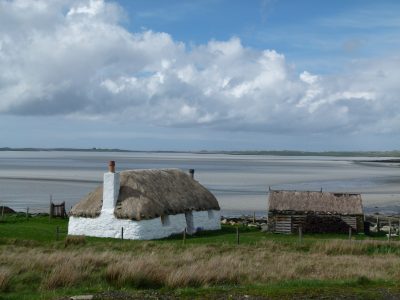 We were given a list of emptying points and informed that wild camping was permitted. Drove to Kildonan birthplace of Flora Macdonald and this area is one of the best places to see traditional Hebridean crofts in states from total dereliction to restored glory. One of the cottages is a youth hostel which administers motorhome parking where we spent the night. There are ruins of the ancient Howmore Abbey. During the evening we were entertained by corncrakes calling but did not get to see the elusive birds!
We were given a list of emptying points and informed that wild camping was permitted. Drove to Kildonan birthplace of Flora Macdonald and this area is one of the best places to see traditional Hebridean crofts in states from total dereliction to restored glory. One of the cottages is a youth hostel which administers motorhome parking where we spent the night. There are ruins of the ancient Howmore Abbey. During the evening we were entertained by corncrakes calling but did not get to see the elusive birds!
Sat 6thDrove to Lochskipport a now deserted fishing quay in the hope of seeing golden eagles/otters but nothing to be seen it was still very windy so they must have all been hiding. Back to ‘main road’ and crossed the causeway onto Benbecula where we stopped at the excellent Co-op for supplies. Drove over 2nd causeway to North Uist and down a twisty but scenic road to Loch Euphort but again no luck with otters/eagles. Booked into Moorcroft Campsite (last pitch) excellent facilities. £19 inc elc . Huge thunderstorm in evening.
Sun 7th Heavy rain until 11.30 left camp and drove to RSPB Reserve at Balranald North Uist. After a very windy walk out to the dunes where we spotted turnstones, ringed plovers, sanderlings, corn buntings, redshanks, lapwings and dotterels we actually saw, photographed and filmed the elusive corncrake! After lunch drove to Lochmaddy North Uist’s ferry port, here we met some motorhomers whom we had previously chatted to and they told us they had spent the morning watching a golden eagle ! Continued on through much more rugged scenery and then crossed the causeway to Berneray. Absolutely fabulous! Lots of grey and common seals basking on the rocks. Huge pure white shell sand beaches, wonderful grassy headland for wild camping but as we had an early start the next day we headed back to the ferry terminal at Ardmaree where we spent a very windy van rocking n rolling night!
Mon 8th Boarded ferry 7.15am crossing the Sound of Harris interesting sail through a myriad of small islands and reefs. Arrived Leverburgh, Isle of Harris. Harris has a wide range of landscapes. On the west coast lie some of the most spectacular beaches of Britain with soft startling white sand, lapped by turquoise water, reminiscent of the Caribbean. In the north, the terrain is rugged, mountainous and has a lunar feel to it, with huge boulders littered around. To the east lies the Golden Road, a great drive that hugs the crenellated east coast visiting a picturesque series of villages, bays and harbours this is a road best explored by car or bike although we had no problems in our large van. After stopping for breakfast we drove around the west coast to Tarbert a small township with 2 grocery shops, a vintage hardware store and a post office. It also has a garage (of sorts) where we bought some fuel £1.55 per litre! We made the tortuous drive out to see the lighthouse at Eilean Glas on the island of Scalpay but there was nowhere to park! However we did see a magnificent sea eagle gliding along the Loch. Back to Tarbert to drive on towards the Isle of Lewis (Lewis and Harris are actually one and the same island). Lewis is dominated by flattish peat moorland with most of the population living in or around Stornaway. We headed East for Uig and the campsite at Cnip (pronounced Cneep). This small site was once a popular wild camp spot but is now managed by the local community. There are a number of small caravans all occupying the prime sites (none occupied whilst were there) there are no marked pitches, the ground is undulating but we managed to find a spot to park. There are toilets and showers water and emptying. The lack of smart facilities is easily compensated by the outstanding scenery and glorious beach. During the evening a local villager arrived to collect the £9 overnight fee.
Tues 9th Raining Low cloud! Aborted out planned visit to the Uig Peninsular and made our way to the site of the Callanish Standing Stones one of the most significant and important megalithic complexes in Europe. It consists of rows of Lewisian rock arranged in circles and a cross with a small chambered cairn. The weather improved as we continued on to the Gearrannan Blackhouse Village. This unique group of restored thatched cottages was last occupied in the 1970’s. For a small charge its possible to take a step back in time to learn and experience the way of life in a typical crofting township of the last century including the weaving of the famous Harris Tweed. After lunch we continued our journey North with the peat moor becoming more and more desolate as we made our way to the Butt of Lewis about as far as you can go in the Western Isles. It achieves a mention in the Guiness Book of Records for being the windiest place in the UK and it was certainly living up to its reputation whilst we were there! The Butt of Lewis Lighthouse stands 121ft high and was built by David and Thomas Stevenson. A short drive took us to Port Nis a picturesque fishing village and then back to the main road with a quick photo stop at the Whalebone Arch the jawbone of a blue whale washed up on a nearby beach in the 1920’s. Then on to our cho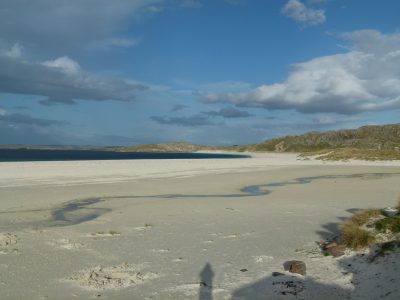 sen wild camp spot for the night, the lower carpark (toilet & water) at Dail Mor beach, popular with surfers who come here to ride the long rollers coming in from the Atlantic.
sen wild camp spot for the night, the lower carpark (toilet & water) at Dail Mor beach, popular with surfers who come here to ride the long rollers coming in from the Atlantic.
Wed 10th Lovely morning after a good walk on the beach we took the scenic route across bleak peat moor to Stornaway passing peatcutters on the way. At Stornaway there is an excellent Co-op and a fuel station. We parked by the fishing Quay and walked around the town calling in at the library to use the free internet to pick up our emails. After a fish n chip lunch we drove up to Lews Castle once owned by Lord Leverhulme (famous for sunlight soap and detergents) who bought the castle and the island in 1918 with aspirations of building a fishing port at Leverburgh, unfortunately the herrings diminished and his dreams with them and in 1923 he gave the Island back to the people of Lewis. We had read about a good wild camp spot at Huishinish on the SW tip of N Harris so we set off to see for ourselves. Huishinish is at the end of a 14mile single track road and it twists and turns like a corkscrew and up and down like a helter skelter. At one point it passes through the gardens of Huishinish Castle before terminating at the small croft township. Wild Camping is allowed at the Community Hall (toilet & water) but spaces are limited – we had the last space and others that arrived had to turn around and face the long 14 miles back. At one time it was possible to park up on the grassy headlands but this is now all fenced off. Had a good walk along the beach and over the headland and spotted a golden eagle soaring above. Very cold evening!
Thurs 11th Lovely Morning. Drove back to Tarbert to do a section of the Golden Road before boarding the ferry to Uig on Isle of Skye at 11.50. Very smooth crossing but as we approached Uig the weather deteriorated and became misty and wet. Well they do call it the “Misty Isle”! Arrived Skye and headed north stopping at the Memorial to Flora Macdonald, the Jacobite heroin, who brought Bonnie Prince Charlie to Skye – in the flight after Culloden, disguised as her maid. Next we pass Duntulm Castle ruins with its bloodthirsty history (and hoards of tourists!) At Kilt Rock viewpoint we dodged the coach loads of tourists to view the Kilt Rock Waterfall as it plunges down to the sea. The Trotternish Peninsular has a high ridge of rocks and the road hugs the coastline with fine views on a clear day. Inland there are wild rock formations, the most famous being the Old Man of Storr and at Staffin the pinnacles of the Quiraing. However with the weather still poor we headed for the excellent campsite at Torvaig nr Portree. £15 inc elc.
Fri 12th Better morning. Drove down to Portree lovely small town popular with visiting cruise ships. Decided to go on a Sea Eagle spotting boat trip aboard the MV Stardust. This was most enjoyable and although we did not see the eagles flying we did see them on their nest with their young. Next on the agenda was a trip to Dunvegan Castle home of the Chiefs of Clan Macleod for 800 years. The castle is situated on a rocky headland at the head of a Loch, is Skye’s most historical sight, and well worth a visit. We continued our tour to the Ardmore Peninsula where we found a small carpark at Trumpan Head where we could spend the night. It was a dramatic evening with the wind howling, the rain lashing down and the sea boiling over the rocks at the foot of the cliffs.
Sat 13th Rain cleared and we were able to get out to view the memorial and the ruins of Trumpan Church, site of a fierce battle between the Clan Macleods and the Clan Macdonalds. Then on to Neist Head and its lighthouse, It’s a narrow tortuous road to Neist Point, there is no road to the lighthouse and all supplies have to be winched down a cable car.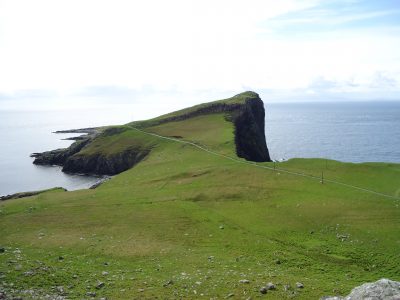 There are a series of very steep steps down on to the point but it is well worth the effort as the views of the cliffs and the outlying islands of the Western Isles are amazing. There were also lots of nesting seabirds and we spent some time watching a pair of nesting Great Skuas. We returned to Dunvegan to the campsite at the head of the Loch £16 incl elec.
There are a series of very steep steps down on to the point but it is well worth the effort as the views of the cliffs and the outlying islands of the Western Isles are amazing. There were also lots of nesting seabirds and we spent some time watching a pair of nesting Great Skuas. We returned to Dunvegan to the campsite at the head of the Loch £16 incl elec.
Sund 14th Dismal morning wet & misty Late start. Went to the Aros Visitor Centre near Portree well worth a visit lots to see. We watched a beautiful film all about Skye its history, culture and wildlife. After lunch drove over the Skye Bridge past the Gavin Maxwell Museum to the Kyle of Lochaish to the little village of Plockton made famous by the Hamish Macbeth TV series. Still dismal so headed for the nearest campsite at Balmacara. Watched Countryfile for weeks weather and decided to abandon our planned route up the West Coast of Scotland and head East for better weather.
Mon 15th Still wet & misty. Heading East! Arrived Rosemarkie on the Black Isle. Booked in to C&CClub site. Very busy all h/u booked for weeks ahead. We loved this site its quiet, unspoilt and well managed. The pitches are a bit uneven. The facilities are good. The site is set right on the edge of beach with the delightful small village of Rosemarkie a short walk away it has two shops, a pub, cafe and a museum. After dinner we left the van to walk the mile to Chanonry Point . The weather was much improved but still very windy and we had quite a battle to stay on our feet. The purpose of our visit was to see bottle- nosed dolphins.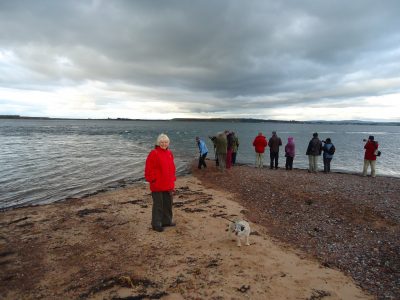 There was already a group of people on the spit of land at the point and this is the place to see the dolphins. The dolphins drive the fish into the shallows so that they are trapped and easy to catch. We saw a pod of at least a dozen, some with young, some with large salmon in their mouths, splashing and jumping out of the water, and all within a few feet of where we were standing. It was a very magical experience, and difficult to drag ourselves away.
There was already a group of people on the spit of land at the point and this is the place to see the dolphins. The dolphins drive the fish into the shallows so that they are trapped and easy to catch. We saw a pod of at least a dozen, some with young, some with large salmon in their mouths, splashing and jumping out of the water, and all within a few feet of where we were standing. It was a very magical experience, and difficult to drag ourselves away.
Tues 16th Lovely morning! Took Midge for walk on beach and in evening returned to point for more dolphin watching. Lots of seals in sea.
Wed 18th Nice morning. Drove to Cromarty and parked by small harbour. There is a small 2 car ferry that runs from Cromarty to Nigg and we knew that a new 4 car ferry was being launched on the 18th so we were hoping to watch the event. Cromarty is a delightful little town and the locals, school children, local digniteries, local TV etc had turned out for the launch. 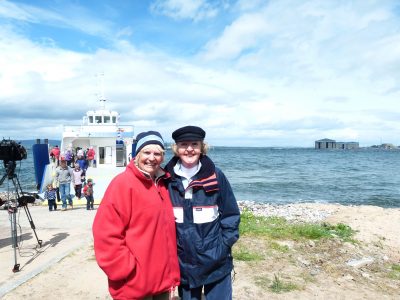 The family that run the ferry had invited Penelope Keith to do the Honours as she is a staunch supporter of the Ferry. At 11am we were all in place for the grand launch and Penelope arrived dressed very nautically and duly christened the new ferry in the traditional manner. We were all then invited on board for a short trip down the Cromarty Firth with champagne and canapés and accompanying fire tender vessel spraying us with water! It was all great fun. We also discovered that the town welcomes motorhomes to free park on the playing field adjacent to the beach.
The family that run the ferry had invited Penelope Keith to do the Honours as she is a staunch supporter of the Ferry. At 11am we were all in place for the grand launch and Penelope arrived dressed very nautically and duly christened the new ferry in the traditional manner. We were all then invited on board for a short trip down the Cromarty Firth with champagne and canapés and accompanying fire tender vessel spraying us with water! It was all great fun. We also discovered that the town welcomes motorhomes to free park on the playing field adjacent to the beach. 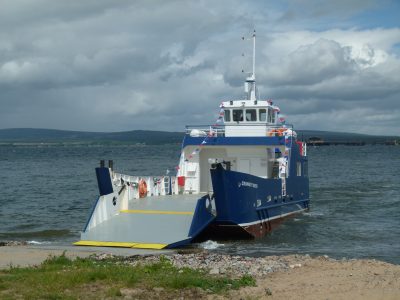 Several motorhomes were parked up and all said it was good with no problems. After lunch carried on heading up the east coast to Brora and CClub site at Dalcham where we had the last pitch. This is a very nice but busy site adjacent to a huge sand beach backed by sand dunes and an impressive golf course. It was so windy that we could hardly walk on the beach with Midge because of the flying sand getting in her eyes.
Several motorhomes were parked up and all said it was good with no problems. After lunch carried on heading up the east coast to Brora and CClub site at Dalcham where we had the last pitch. This is a very nice but busy site adjacent to a huge sand beach backed by sand dunes and an impressive golf course. It was so windy that we could hardly walk on the beach with Midge because of the flying sand getting in her eyes.
Thurs 19th Sunny/windy. Continued on A9 travelling North. Very scenic coastal road passing through or near some delightful small towns and villages. Stopped at Badbea near Helmsdale.
Badbea Highland Clearance Village and Memorial is just a couple of miles north of Helmsdale, on the A9. There’s a road sign on the left and a small car park on the right, with a storyboard and a gate. It’s easy to reach, and the village is only a few minutes walk away although a little steep in places and stout shoes recommended. Badbea is the haunting site of a now abandoned settlement. In the 1840s a whole community was ejected from the fertile glens to make way for the Landowners sheep. With nowhere to go they found a piece of ground they could settle on. It was on a steep hillside above sheer cliffs and open to the North Sea weather, so windy they had to secure their animals and children with tethers to stop them from blowing away over the steep cliffs. More than 60 people formed the original community in the 1840s. They farmed a few animals, some of the men took to fishing. Within 60 years they’d all left – mostly emigrated to the new world. The son of one of them returned from New Zealand to build the monument which today tells us the names of the families, and in some cases what happened to them. The memorial and the boards tell the story but all we can see today is piles of stones which were once walls to their cottages . The final scene is the Memorial Park in Helmsdale built so we wouldn’t forget the injustice of the Highland Clearances.
Stopped for lunch at Wick. An interesting town with a large harbour, Heritage Centre and the Old Pulteney Distillery. In the 1900’s there was a huge herring fishing industry which was very hard and thirsty work! Carried on along gorse clad hills until we reached John O Groats. Drove out to Duncansby Head (no overnight parking) and walked along the cliffs to view the stacks and nesting seabirds. The lighthouse is at the tip of the most NE point of Gt Britain. 6pm returned to John O Groats (by this time all the tourists had gone – no overnight parking) and decided to stay the night in the JOG campsite overlooking the Pentland Firth. £15 no elect. and poor facil. But a wonderful view and very quiet. Wandered around the now deserted area at JOG and watched the arrival of the passenger ferry between JOG and The Orkneys and decided to book a day trip for the following day.
Frid 20th May Boarded the ferry Pentland Venture at 8.45am for our Maxi Day Tour of Orkney (£49 each no charge for Midge) It took 40 minutes to cross the Pentland Firth a notoriously rough and wild stretch of water, and indeed it was, our little boat tossing and shuddering in huge waves. Arriving at Burwick on South Ronaldsay we found our coach waiting for us together with our driver/guide for the day. It would take a whole newsletter to write about the delights of the Orkneys so I will have to be brief! From Burwick we made our way over the Churchill Barriers built to protect the Atlantic Fleet in WW2 after the disastrous sinking of the British battleship Royal Oak by a German submarine which had managed to manoeuvre its way through sunken blockade ships. Driving along by Scapa Flow wrecks of the sunken blockade ships can be still be seen. Our tour stopped at the pretty town of Stromness, once the last port of call for sailing ships on their way to the Americas. We wandered around the narrow streets and came across the ‘Kyber Pass’ once a notorious red light district. After a delicious fish n chip lunch we were off again this time to the Bay of Skaill, where stoneage man chose to build the village of Skara Brae . Rediscovered only 160 years ago, the village had been hidden under sand dunes, perfectly preserved for almost 5,000 years, until a violent storm in 1850. Our Tour then travelled along the lochs of Harray and Stennes with a photo stop at the mystical Ring of Brodgar and the Standing Stones of Stenness. On to Kirkwall and an opportunity to see the magnificent cathedral of St. Magnus where the tomb of John Rae lies the discoverer of the North West Passage. Also the ships bell from the Royal Oak, a poignant reminder of the atrocities of war. 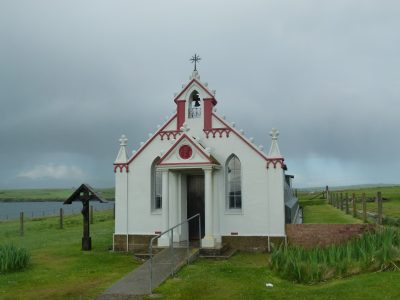 Returning to our homebound ferry we once more cross the Churchill Barriers stopping this time to view the small Italian Chapel constructed inside two Nissen huts and most beautifully decorated, using simple tools and raw materials, by the Italian P.O.W. brought there to build the Churchill Barriers. Our ferry arrived back at JOG at 8.15pm. The day out had been perfect. Lovely weather, excellent and entertaining commentary from our driver/guide and good company from other passengers. Two of whom we spent some time with (Joe and Jim) and received an invitation to camp for the night at the home of Joe who lived nr Thurso. We had a wonderful entertaining evening in Joe’s beautiful wooden Swiss Chalet type home finally getting to bed at sometime past midnight.
Returning to our homebound ferry we once more cross the Churchill Barriers stopping this time to view the small Italian Chapel constructed inside two Nissen huts and most beautifully decorated, using simple tools and raw materials, by the Italian P.O.W. brought there to build the Churchill Barriers. Our ferry arrived back at JOG at 8.15pm. The day out had been perfect. Lovely weather, excellent and entertaining commentary from our driver/guide and good company from other passengers. Two of whom we spent some time with (Joe and Jim) and received an invitation to camp for the night at the home of Joe who lived nr Thurso. We had a wonderful entertaining evening in Joe’s beautiful wooden Swiss Chalet type home finally getting to bed at sometime past midnight.
Sat 21st Drove to Dunnet Head The most Northerly Point of mainland Britain – No overnight parking. No Puffins! We had last visited here in 1986, then there were hundreds of them nesting on the slopes of the steep cliffs, together with other seabirds, now none. We carried on to visit the Castle of Mey, formerly the holiday home of the late Queen Mother. This small homely castle is well worth a visit, it gives a very intimate insight to the Royal Family and it’s not difficult to imagine the happy times the late Queen Mother spent there. Driving along the north coast the scenery was everchanging and with some of the most famous surfing beaches in Europe. We arrived at Durness and the Sango Sands Caravan Site situated overlooking a glorious beach. Gale force winds were forecast so we were not too disappointed to find all the ‘seaview’ pitches already taken. £15.60 incl ele.
Sun 22nd After a very windy night we set off for the short drive to Keodale to catch the small ferry across the Kyle of Durness to Cape Wrath a longtime ambition for Arthur to visit this most NW point of the British mainland. The Cape can only be reached by the small passenger ferry from Keodale and then by mini bus or by a very long walk from the South as there are no roads. We were unsure whether we would be able to make the crossing as the wind was still very strong and the water very choppy. After parking up the van in the large carpark at the head of the Loch we walked down to the small jetty where the ferry went from. There were a few others all wondering if it would be possible to do the crossing. The ferry man arrived and stated that he would be willing to take us but could not guarantee a time to get us back if the wind increased. As the Cape is virtually uninhabited this was not good news for some however the driver of the mini bus, JenArtMidge and 8 others decided to take a chance. On the other side we climbed aboard the mini bus to make the 11 miles (18 km) journey to the lighthouse along a bumpy narrow track through desolate rocks and moor. This area is used as a military bombardment range by the Royal Navy and the Royal Airforce hence travel to the Cape is restricted at certain times of year. It is the only place in the Northern Hemisphere where Nato forces combine land, air, and sea capabilities in assault mode for training maneouvres, deploying ordnance up to 1,000-pound (450 kg) bombs. Along the way we came across a herd of red deer sheltering from the wind. The 45 minute bus drive is an experience to remember (it also comes with a witty commentary from the driver). We were fortunate to see the spectacular Cape Wrath at its most dramatic with howling wind and waves crashing against the rocks 400ft below. The lighthouse built in 1828 by Robert Stevenson was manned until 1998 when it was converted to automatic operation. The block of crumbling white houses next to the lighthouse are mostly currently disused, although one has been renovated over the past ten years, and another is home to a room with information about George Stephenson. The sole inhabitants are now John Ure and his family, who leased the main building, converted it into a three-bedroomed home, and who have opened what is claimed to be Britain’s most remote cafe, the Ozone Cafe was opened in 2009 by the Princess Royal, and seats eight people. It is open all hours of the day and night throughout the year.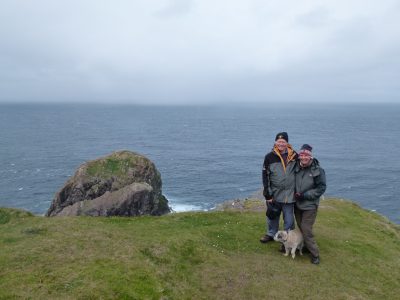 Whilst we were there we were lucky to see the supplies ship and helicopter bringing in fuel for the Lighthouse – quite a spectacle in the wind. Back at the quay the ferryman informs us that as the wind is now gale force he cannot take us back to the mainland! However after a while he said he would try to take some of us but we would have to land in a small bay away from Keodale. So a young couple, JenArtMidge and two lady hikers agreed to give it a go. It was a very rough ride across the choppy water. We could not land in the bay so had disembark on rocks, climb up a small cliff and then battle our way against the wind back to Keodale. The remaining passengers were to spend another 4 hours on the desolate quay until it was safe to cross. We spent a wet and windy night in the car park. Good for bird watching. Lots of waders also arctic skuas.
Whilst we were there we were lucky to see the supplies ship and helicopter bringing in fuel for the Lighthouse – quite a spectacle in the wind. Back at the quay the ferryman informs us that as the wind is now gale force he cannot take us back to the mainland! However after a while he said he would try to take some of us but we would have to land in a small bay away from Keodale. So a young couple, JenArtMidge and two lady hikers agreed to give it a go. It was a very rough ride across the choppy water. We could not land in the bay so had disembark on rocks, climb up a small cliff and then battle our way against the wind back to Keodale. The remaining passengers were to spend another 4 hours on the desolate quay until it was safe to cross. We spent a wet and windy night in the car park. Good for bird watching. Lots of waders also arctic skuas.
Mon 23rd Still wet/windy 70mph winds forecast. Now travelling south. 1st stop Kinlochverbie a large but deserted industrial port. Further on is another fine beach at Oldshore. Beyond Rhiconich we enter into a much more rocky and mountainous region. Following the A894 we pass through Laxford Bridge and Scourie (Spar Shop and Campsite). We had planned to stay here to take a boat trip to Handa Island for birdwatching but the weather god was against us and we carried on to Kylesku for lunch stopping at the ruined Ardvreck Castle, a 16c Macleod stronghold, backed by the massive Quinag mountain. We abandoned the coastal route to Lochniver in favour of the A837 along Loch Assyant. What we did not know was that we were to encounter huge lorries tearing along in the atrocious conditions to the Port of Lochniver one nearly put us off the road and we saw one on its side. The attractive village and fishing port of Lochniver is a popular holiday centre, within the outstanding beauty of the Stoer Peninsular with its many charming crofting communities and sandy coves. It attracts many hill walkers as this is the starting point for the ascent of Assyant’s most amazing peak, Suilven. With the weather deteriorating we had to make do with photographs, maps and models in the excellent Assyant Visitor Centre. Back to the A837 and past the two Munros Ben More Assynt and Conival, dark and shrowded in mist. There is a series of extraordinary mountains along this stretch of road – all of them tempting to the hill walker. We eventually arrived at Ardmore Campsite situated on a small headland overlooking Loch Kanaird £19 incl h/u. At 10.30pm the gale was so severe we had to move pitch to hide behind a high hedge!
Tues 24th Wet morning. Drove to Ullapool then on to Corrieshalloch Gorge. Walked across the 150ft high suspension bridge over the Falls of Measach a very impressive waterfall. Continued on the A832 the coastal route. The weather had improved and the road took us pass Loch Broom, below the powerful An Teallach highest of the Torridon Peaks. Next Gruinard Bay ,with its coves of pink sand although it holds a dark secret. In 1942 Gruinard Island ¾ mile offshore was used as an experiment in germ warfare by the MOD and up until 1986 was still contaminated with the deadly Anthrax spores. After a determined decontamination programme the Island was declared safe in 1990. We decided against a paddle even though it looked very inviting! At Aultbea on Loch Ewe we stopped to view the wartime defence posts. Loch Ewe was also one of the main convoy assembly lochs during WW2 and a string of disused fortifications can be seen along the lochside. We also came across a large pier with “Strictly No Admittance” which is a NATO refuelling base. At the village of Poolewe we managed to secure the last pitch on the C&CC site. We had planned to visit the National Trust Inverewe Gardens but it was too late.
Wed 25th Weather still windy and unsettled and the news tells us that we are going to be covered in volcanic ash! We had planned to take the coastal road to Applecross and the old drove road over the Bealach Na Ba (Pass of the Cattle). It has several tight hairpins and from the summit on a clear day it’s possible to see the Western Isles. We decided that as the weather was so poor it would be better to head East again and leave the Applecross Peninsular for another trip. Leaving Poolewe the road crosses a moorland plateau before climbing to Gairloch the main centre of Western Ross. After Gairloch the road enters Beinn Eighe National Reserve. Ancient Scots Pines cover the hillsides and the road follows the shore of Loch Maree, one of the most beautiful lochs in the Highlands dominated by the mass of Slioch filling most of the skyline on the Eastern shore. A visit to the Aultroy Visitor Centre is recommended, there are trail marked walks for all abilities and a fascinating exhibition which explains the natural history of the region. Two miles down the road we come to Kinlochewe a popular base for walking and climbing in this area. There is a lovely view of Glen Docherty as the A832 climbs towards Achnasheen. After a pleasant drive we reached the RSPB Reserve at Loch Garten. They have a camera on an osprey nest and we watched as EJ and Odin the female and male ospreys carefully fed their tiny chicks (they were only a few days old) there was also a camera on a goldeneye duck sitting on a clutch of eggs. We also saw red squirrels, lots of birds including siskins and woodpeckers. Stayed the night at a CClub site at Newtownbridge.
Thurs 26th Are next planned stop was Edinburgh and we had booked ahead for two nights at the CClub Site. We stopped at the Asda at Perth for shopping and fuel before stopping at Queensferry to view the Forth Bridges. Historic South Queensferry has cobbled streets, distinctive Scottish architecture and the Hawes Inn, which features in the novel “Kidnapped” by Robert Louis Stevenson. The Forth Road Bridge when opened, on 4 September 1964 by Her Majesty Queen Elizabeth II, was the largest suspension bridge in Europe, and, together with the approach viaducts is over 2½ km. (over 1½ miles) long). The Forth Railway Bridge, the world’s first major steel bridge, with its gigantic girder spans of 521m. (1710 ft.) ranks as one of the great feats of civilization. It was begun in 1883 and formally completed on 4 March 1890 when HRH Edward Prince of Wales tapped into place a ‘golden’ rivet. Today, the bridge, Scotland’s biggest ‘listed’ building, continues to form a vital artery in Network Rail’s East Coast railway system; it carries 180 – 200 train movements per day. After booking in to the very busy Edinburgh CClub Site we went for a good walk along the esplanade overlooking the Firth of Forth.
Friday 27th Decided against taking the motorhome into Edinburgh, the bus stop was a mile away so went on the camp mini bus £5 per person return, (no charge for Midge). On arrival we first made our way through the park up to the Castle (no dogs inside) so had a look around the outside walls, parade ground and watched the changing of the guard. At the Royal Mile we caught a city tour bus and had an enjoyable time discovering the history and architecture of Edinburgh without lots of walking!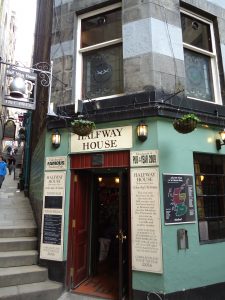 We stopped to have lunch in The Halfway House which claims to be the smallest pub, neeps and haggis was on the menu, but we stuck to the Lasagne. We enjoyed our day out but it was the Bank Holiday Weekend and very busy everywhere.
We stopped to have lunch in The Halfway House which claims to be the smallest pub, neeps and haggis was on the menu, but we stuck to the Lasagne. We enjoyed our day out but it was the Bank Holiday Weekend and very busy everywhere.
Sat 28th Left site and drove to Ocean Terminal to see the Royal Yacht Brittania. Over 250,000 people visit every year, one of the UK’s top evening venues, Zara Phillips and Mike Tindall recently celebrated their forthcoming wedding with a cocktail party aboard the yacht. The racing yacht Bloodhound once owned by the Queen is berthed alongside Brittania.
Following the coastal route we reached the delightful town of North Berwick It has two spotlessly clean beaches divided by the Scottish Seabird Centre and the town’s harbour. Standing behind the town is North Berwick Law, an 800ft extinct volcano seen like a beacon for miles. The east beach had a parking area, suitable for motorhomes, overlooking the beach. We were told by a local that it is ok for us to stay the night – so we did!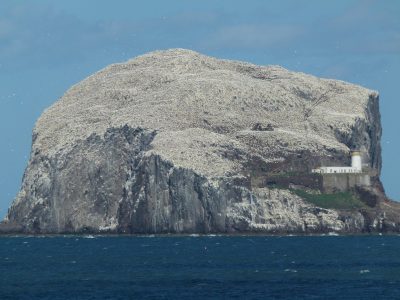 We had a lovely walk over the headland looking out to sea at the spectacular Bass Rock, home to 80,000 nesting gannets, hence its ‘whitewash’ appearance it’s a sight not to be missed if you are in the area. The lighthouse was installed in 1902 on the remains of a prison.
We had a lovely walk over the headland looking out to sea at the spectacular Bass Rock, home to 80,000 nesting gannets, hence its ‘whitewash’ appearance it’s a sight not to be missed if you are in the area. The lighthouse was installed in 1902 on the remains of a prison.
Sun 29th After a magical evening watching the sun go down over the beach we woke to drizzle! Continued along the coastal route passing the ruined Tantallon Castle perched over a high cliff guarding the Firth of Forth and Bass Rock. We next made for Dunbar to join the A1 and then a detour to St Abbs Head. However this proved to be too far a walk for the time we had and the tiny village of St Abbs is a no go for motorhomes so we carried on to Eyemouth where there was easy parking on the seafront. The weather improved as we crossed the border back in to England and approached Berwick-Upon Tweed another delightful town with three bridges and a castle. Historic Berwick is the most northerly town on the Northumberland Coast and is considered to be one of the most picturesque. This is mainly because of its attractive red-roofed houses, pinkish grey elegant Georgian buildings and it’s location at the mouth of the River Tweed. Midge met many of her relatives in Northumberland, being the birthplace of the Border Terrier! The sun was shining as we turned off the A1 to take the coastal road. Soon the magnificent spectacle of Bamburgh Castle came into view, and so did all the tourists! It was Bank Holiday Sunday, most definitely not a good time to visit this area, it was heaving with traffic and people. We carried on to Seahouses for more of the same so only stayed long enough to collect details of the boat trips out to the Farne Islands. Two miles up the road we came across a Caravan & Camping Club Holiday Site and booked in for 2 nights £6. Per night
Mon 30th Dull & Drizzle. We had decided to ride the bikes into Seahouses not to take Midge so before we left took her for a nice long walk over the sand dunes and along the beach opposite the site. Our boat trip was the 1st of the day at 12.00pm and was to last 2-3 hours so packed a sandwich and a drink and set off on our bikes. We boarded the M.V. Glad Tidings leaving the calm of the harbour to head out to the open sea, after the strong winds we had been experiencing it was relatively calm making bird spotting much easier. For me, I was at last fulfilling one of my dreams, to visit The Farnes and I was not to be disappointed.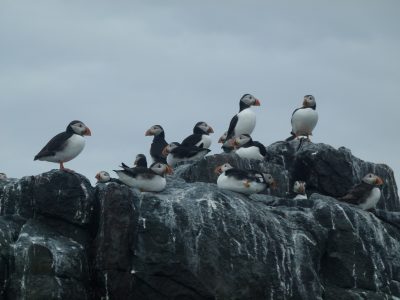 As we got closer to the Islands more and more birds were to be seen bobbing about on the sea, and there was great excitement on the boat when the first Puffin was spotted. After touring around the rocky islets to see the seals the boat made for Staple Island where it squeezed in between gullies in the rocky stacks so that we could see, photograph and hear at close-hand the amazing scene of thousands of nesting birds. It was truly wonderful, there was hardly room for blade of grass so closely packed were the colonies of birds. The Kittiwakes had chicks, delightful balls of fluff, the Puffins had their own special area where they were lined up perched on the tops of the stacks like rows of little parrots, taking a break from fishing for sand eels. During the nesting season there are twenty different species of breeding sea birds on the Islands, including Guillemots, Razorbills, Eiderducks, Terns and a staggering seventy thousand Puffins. Next our boat took us to Inner Farne the largest of the Farne Islands and owned by the National Trust. There is a charge for landing on Inner Farne (free for N.T. Members) and is a complete contrast to Staple Island. Its paths are a mixture of boardwalks and grassy slopes, and its birdlife is surprisingly different.
As we got closer to the Islands more and more birds were to be seen bobbing about on the sea, and there was great excitement on the boat when the first Puffin was spotted. After touring around the rocky islets to see the seals the boat made for Staple Island where it squeezed in between gullies in the rocky stacks so that we could see, photograph and hear at close-hand the amazing scene of thousands of nesting birds. It was truly wonderful, there was hardly room for blade of grass so closely packed were the colonies of birds. The Kittiwakes had chicks, delightful balls of fluff, the Puffins had their own special area where they were lined up perched on the tops of the stacks like rows of little parrots, taking a break from fishing for sand eels. During the nesting season there are twenty different species of breeding sea birds on the Islands, including Guillemots, Razorbills, Eiderducks, Terns and a staggering seventy thousand Puffins. Next our boat took us to Inner Farne the largest of the Farne Islands and owned by the National Trust. There is a charge for landing on Inner Farne (free for N.T. Members) and is a complete contrast to Staple Island. Its paths are a mixture of boardwalks and grassy slopes, and its birdlife is surprisingly different. 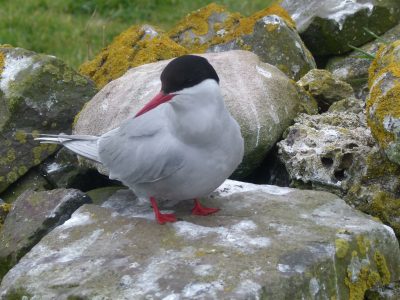 The first bird encounter is the Arctic Tern, they nest on the slope leading from the landing stage and attack visitors mercilessly for approaching their nests. (its advisable to wear a hat) The path leads past nesting sandwich and roseate terns and brings you nose to beak with nesting eiders adjacent to the path. Nesting in the centre of the island are large numbers of puffins, their burrows scattered liberally around the short grassland. The path continues to a viewing point over a huge colony of nesting Guillemots, Razorbills, and Shags. Closest to the fence were the Shags, sitting on their nests many with well grown chicks, they were very approachable and being able to observe so closely we could see the Shag’s green eye and iridescent sheen to it’s oily feathers. It was almost too much to take in. All too soon it was time to return to ‘Glad Tidings’ and Seahouses but not before we had motored past Longstone Lighthouse on the outer group of the Farnes. It was made famous on the 7th September 1838 by Grace Darling when she and her father rescued nine survivors from the Forfarshire, a paddle steamer which ran aground in stormy seas. After cycling back we took Midge for a short walk and then sat outside with a G&T and reflected on a perfect day.
The first bird encounter is the Arctic Tern, they nest on the slope leading from the landing stage and attack visitors mercilessly for approaching their nests. (its advisable to wear a hat) The path leads past nesting sandwich and roseate terns and brings you nose to beak with nesting eiders adjacent to the path. Nesting in the centre of the island are large numbers of puffins, their burrows scattered liberally around the short grassland. The path continues to a viewing point over a huge colony of nesting Guillemots, Razorbills, and Shags. Closest to the fence were the Shags, sitting on their nests many with well grown chicks, they were very approachable and being able to observe so closely we could see the Shag’s green eye and iridescent sheen to it’s oily feathers. It was almost too much to take in. All too soon it was time to return to ‘Glad Tidings’ and Seahouses but not before we had motored past Longstone Lighthouse on the outer group of the Farnes. It was made famous on the 7th September 1838 by Grace Darling when she and her father rescued nine survivors from the Forfarshire, a paddle steamer which ran aground in stormy seas. After cycling back we took Midge for a short walk and then sat outside with a G&T and reflected on a perfect day.
Tuesday 31st Sunny morning! Early start to catch the tide right for the crossing to Holy Island also known by its celtic name, Lindisfarne, Holy Island is accessible only at low tide, twice daily, by a three mile long causeway, built in 1954. There is a large carpark, with a mini bus service into the Village, it is also a very pleasant walk. We took the mini bus out to the Castle. Holy Island was one of the principle centres of Christianity during the Dark Ages and was given to St Aidan in AD635 by the King of Northumbria. 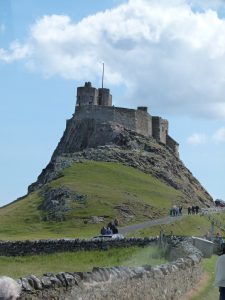 Sitting atop Beblowe Crag is the most prominent feature on the island, Holy Island Castle, built as a defence in Tudor Times. Purchased in 1901 by Edward Hudson, the founder of country Life magazine, Hudson commissioned the archict Edward Lutyens to transform the castle into a home, with much of the original fabrics of the castle remaining today. The Castle is now owned by the National Trust. The second main attraction is the Priory which dates back to Norman times. It is built on the site of an Anglo Saxon Monastery following the visit of St Aidan in AD635 destroyed by the Vikings and rebuilt some 400 years later as a Benedictine Priory. It was then a quick back drive to catch the causeway before it flooded. Back on the A1 we make the short drive to Alnwick (pronounced Annick) and booked into the Rugby Club site for the night. (£10 no h/u) After lunch we walked into the nice old town, with an interesting cobbled market square and quaint shops, before making our way to visit Alnwick Castle (of Harry Potter fame) The castle is one of the largest inhabited castles in England built as a medieval fortress and home to the Percy Family for 700 years. Before returning to the Van we called in at the listed Victorian Railway Station which is now home To Barter Books one of the largest secondhand bookshops in Britain. A must for all bookworms!
Sitting atop Beblowe Crag is the most prominent feature on the island, Holy Island Castle, built as a defence in Tudor Times. Purchased in 1901 by Edward Hudson, the founder of country Life magazine, Hudson commissioned the archict Edward Lutyens to transform the castle into a home, with much of the original fabrics of the castle remaining today. The Castle is now owned by the National Trust. The second main attraction is the Priory which dates back to Norman times. It is built on the site of an Anglo Saxon Monastery following the visit of St Aidan in AD635 destroyed by the Vikings and rebuilt some 400 years later as a Benedictine Priory. It was then a quick back drive to catch the causeway before it flooded. Back on the A1 we make the short drive to Alnwick (pronounced Annick) and booked into the Rugby Club site for the night. (£10 no h/u) After lunch we walked into the nice old town, with an interesting cobbled market square and quaint shops, before making our way to visit Alnwick Castle (of Harry Potter fame) The castle is one of the largest inhabited castles in England built as a medieval fortress and home to the Percy Family for 700 years. Before returning to the Van we called in at the listed Victorian Railway Station which is now home To Barter Books one of the largest secondhand bookshops in Britain. A must for all bookworms!
Wed 1st June Sunny. Set off early and had an interesting drive across scenic moor to visit Cragside. Situated near Rothbury it was the family home of Lord Armstrong, a Victorian inventor and industrialist. Cragside was the first building in the world to be lit by hydroelectricity and a walk around the National Trust property reveals a wealth of ingenious gadgetry including fire alarm buttons, telephones, a passenger lift and a Turkish bath suite. Outside Cragside is one of Europe’s largest rock gardens sloping down to the Debdon Burn. The Iron Bridge over the burn is one of the oldest of its type in the UK. The estate has more than 30 miles of footpaths and lakeside walks including a short walk down to the Power House and the Pump House. After a very enjoyable few hours we made our way to a CL on a farm at Ridsdale near to Hadrians Wall. £6 no h/u.
Thurs 2nd June After a peaceful night, with just sheep for company, we made our way to the B6318 to follow the route of Hadrian’s Wall. We stopped at Housteads which is the most complete example of a Roman fort in Britain. It stands high on the exposed Whin Sill escarpment, commanding breathtaking views. Excavations at the fort have revealed four double-portal gateways, the turreted curtain wall, three barrack blocks and of course the famous well-preserved latrines. At the centre are the most important buildings, the commandant’s house, head-quarters building and hospital. The fort lies uphill from the carpark (a ten minute walk) and is managed by the National Trust. We plan to return to Northumberland and Hadrian’s Wall to explore more of this beautiful county and to visit more sites along the wall. This marked the end of our Tour. We had experienced everything that Scotland has to offer, majestic mountains, beautiful beaches, enchanting islands, wild peat moors, amazing wildlife, very friendly locals and of course the weather!
I hope that you have enjoyed reading this account of our Scottish Adventure. I have tried to make it interesting and informative.
N.B. It may be of interest to some that ‘Wild Camping’ is no longer encouraged in Scotland. There are plenty of places to park a motorhome and in most places that we visited there was no charge, however even the smallest of lay-bys have the No Overnight Parking signs. This has had a knock-on effect and made campsites, especially those in popular areas, extremely busy. It would be wise to book ahead if you are going at a busy time of year. We did not have a problem wild camping in the Outer Hebrides, but again campsites were very busy.
Dogs At no time did we find a dog restriction on any of the beaches or attractions in The Outer Hebrides or on any of the beaches that we visited in Scotland apart from in the Castles and Cragside House (permitted in the gardens).
Midges. We did not encounter any of the small wee beasties. We decided that this was due to the strong winds and cold weather that we experienced throughout our tour.
